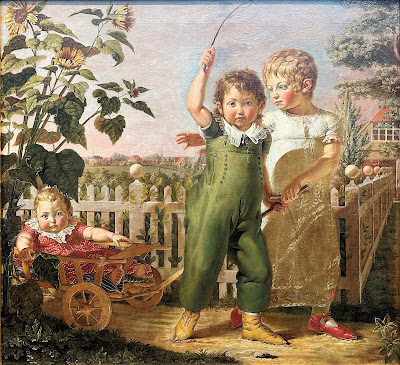|
Herr von Ribbeck auf Ribbeck im Havelland, Ein Birnbaum in seinem Garten stand, Und kam die goldene Herbsteszeit Und die Birnen leuchteten weit und breit, Da stopfte, wenn's Mittag vom Turme scholl, Der von Ribbeck sich beide Taschen voll, Und kam in Pantinen ein Junge daher, So rief er: „Junge, wiste 'ne Beer?” Und kam ein Mädel, so rief er: „Lütt Dirn, Kumm man röwer, ick hebb 'ne Birn.” |
Squire von Ribbeck at Ribbeck in Havelland, In his garden, there stood a pear tree grand, And when autumn came round, the golden tide, And pears were glowing far and wide, Squire von Ribbeck, when noon rang out, would first Fill both his pockets full to burst. And then, when a boy in his clogs came there, He called," My lad, do you want a pear?" He would hail a girl that chanced to pass: "Come over; I have a pear, little lass!" |

|
| ©Friedrich-Carl von Ribbeck |
Here, Friedrich-Carl reads the complete ballad in German to children.
The poet and novelist Theodor Fontane wrote the popular ballad Herr von Ribbeck auf Ribbeck im Havelland in 1889. To date, it has been published in German anthologies and taught in schools. Red Baron doesn't know whether it's still the case, but we learned Fontane's ballad by heart in school.
The text refers to a member of the Prussian lower nobility, Squire von Ribbeck. The family residing at Ribbeck Manor in the Havelland region has been attested since 1237, and the Ribbeck estates are mentioned in the 1375 register of Emperor Charles IV.
The legend of kind-hearted Hans-Georg von Ribbeck (1689–1759) and his pear
tree first appeared in a collection of fairy tales published in 1887. Fontane
used this text as a base for his ballad, which he wrote in the summer of 1889.
Touring the site, there are pears everywhere. We opened our visit, typically German mit Kaffee und Kuchen - a pear (!) pie - and continued with a special guide in the park around the Ribbeck Manor, looking first at the German pear garden.
Touring the site, there are pears everywhere. We opened our visit, typically German mit Kaffee und Kuchen - a pear (!) pie - and continued with a special guide in the park around the Ribbeck Manor, looking first at the German pear garden.

|
| In the park, our local guide stands under the pear tree from Lower Saxony. |
The backside of the Ribbeck Manor. The East German regime expropriated the von Ribbeck family in 1946.
The pear tree of plenty stood in this place, made famous by Theodor Fontane. A storm broke it down on February 20, 1911, and a new tree was planted in 2000. Our excellent tour guide is looking for the text to recite the ballad. This recital was included in the travel service booked.
The new pear tree near the Ribbeck church in the background, and the ceramic sculpture "Pear of Ribbeck" by Juliane E. Gansen.
Pears continue to fill the museum inside the Ribbeck Manor.
A pear to climb into from the other side ...
… and a weathered sandstone torso of King Frederick William I of Prussia. It's a classical pear shape.
Look at Friedrich Wilhelm I., the Soldier King, in a painting by Konstantin Cretius. Here, he received the Salzburg exiles in Berlin on April 30, 1732. The old man with a hat and a cane, lifting his arm, could have been my great-great-great...grandfather. Read more in German.
The Friedrich-Carl mentioned above, von Ribbeck, is the grandson of Hans-Georg Karl Anton von Ribbeck. He was a cavalry captain in the First World War and, during the Weimar Republic, a member of the "Stahlhelm," the association of front-line soldiers. After the Nazi seizure of power, Hans-Georg von Ribbeck refused to join the SA. Although he did not belong to any resistance movement, his opposition led to his arrest in May 1944 as "an enemy of the people."





























































